The Winter Squash Page
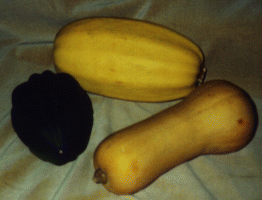
Choosing a Winter Squash.
A lot of people would like to try cooking winter squash, but the varieties vary a lot and picking one can be confusing. Some of them are:
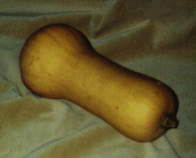 1. Butternut. This is the most common winter squash in
grocery stores. This squash has a peachy orange skin and bright orange
flesh color. It has a long neck with a base that is round which holds the
seeds. If you select a Butternut squash, pick the one with the thickest
neck and the smallest round base, as it will have the most edible flesh.
Choose the one with the darkest peachy-orange color and stay away
from the ones that are off-white with a greenish tinge, as they are not
ripe. The oranger the color, the riper, drier and sweeter the squash.
The illustration shows an excellent example with a broad neck and small portion
containing seeds. The peachy-orange color shown here is excellent.
1. Butternut. This is the most common winter squash in
grocery stores. This squash has a peachy orange skin and bright orange
flesh color. It has a long neck with a base that is round which holds the
seeds. If you select a Butternut squash, pick the one with the thickest
neck and the smallest round base, as it will have the most edible flesh.
Choose the one with the darkest peachy-orange color and stay away
from the ones that are off-white with a greenish tinge, as they are not
ripe. The oranger the color, the riper, drier and sweeter the squash.
The illustration shows an excellent example with a broad neck and small portion
containing seeds. The peachy-orange color shown here is excellent.
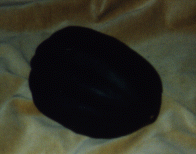 2. Acorn. This squash is also readily found in grocery
stores. The squash is dark green with a series of deep ridges, narrowing
to a tapered point.The flesh is a golden yellow, rather than orange.
When selecting an acorns quash, pick one that is the darkest green--
almost bronze color. Later in the season, into October, squash purchased
in the grocery store will tend to be riper & sweeter. Note the very dark
bronze-green color of the example in the illustration. This squash will be sweet.
2. Acorn. This squash is also readily found in grocery
stores. The squash is dark green with a series of deep ridges, narrowing
to a tapered point.The flesh is a golden yellow, rather than orange.
When selecting an acorns quash, pick one that is the darkest green--
almost bronze color. Later in the season, into October, squash purchased
in the grocery store will tend to be riper & sweeter. Note the very dark
bronze-green color of the example in the illustration. This squash will be sweet.
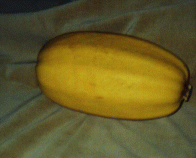 3. Spaghetti. These are also very common in grocery
stores. The flesh of spaghetti squash is very fibrous and stringy, and
some people actually eat it like spaghetti, with marinara sauces, cheese
& everything. The stringy flesh is a creamy white color, and not too
sweet. Spaghetti squash can be used for the recipe that follows, but the
results will be quite different from the other varieties mentioned here.
Some people like this squash better than the others, others not. The
yellowest Spaghetti squash will be the ripest and best to eat. Those that
are nearly white are not very ripe. The excellent example shown here is
yellow, not off-white in color. Because of the yellow color, it
will be very good.
3. Spaghetti. These are also very common in grocery
stores. The flesh of spaghetti squash is very fibrous and stringy, and
some people actually eat it like spaghetti, with marinara sauces, cheese
& everything. The stringy flesh is a creamy white color, and not too
sweet. Spaghetti squash can be used for the recipe that follows, but the
results will be quite different from the other varieties mentioned here.
Some people like this squash better than the others, others not. The
yellowest Spaghetti squash will be the ripest and best to eat. Those that
are nearly white are not very ripe. The excellent example shown here is
yellow, not off-white in color. Because of the yellow color, it
will be very good.
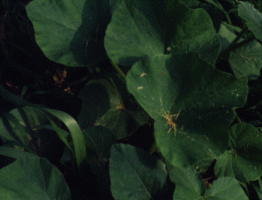 4. Buttercup. A flattened round squash with a white
cup or knob on the underside (flower side), this one is my favorite, as
the flesh is very sweet and dry. The flesh is dark orange, sometimes
almost reddish in color. When purchasing, look for one that is dark
rather than light green, and, again, if you can find one with a bronze
tint, that one will be the driest and sweetest. The plant of the Buttercup
squash is shown in the illustration.
4. Buttercup. A flattened round squash with a white
cup or knob on the underside (flower side), this one is my favorite, as
the flesh is very sweet and dry. The flesh is dark orange, sometimes
almost reddish in color. When purchasing, look for one that is dark
rather than light green, and, again, if you can find one with a bronze
tint, that one will be the driest and sweetest. The plant of the Buttercup
squash is shown in the illustration.
5. Turban. These are larger than the Buttercup and are mostly orange, with a very large knob on the flower end. Some are orange, white and green multicolored. Despite the physical similarities to the buttercup, the yellow flesh here tends to be much moister and not as sweet. I am not a big fan of the Turban squash for eating, although they are very decorative. These are so moist they are not recommended for the recipe.
5. Hubbard. These are very large and irregularly shaped, with a skin that is quite "warted" and irregular. The yellow flesh of these tends to be very moist and longer cooking times in the oven are needed, so this variety is not recommended for the microwave recipe.
There are many other winter squash varieties shown in garden catalogs but these are the ones that are commonly commercially grown and are readily available in grocery stores. The first three are readily available year around, but the others are often found between September and December in the stores.
Twice-Baked Winter Squash
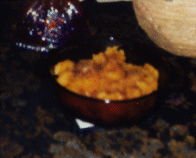
Pick a medium-sized squash. Microwave cooking times vary a lot depending on the wattage of your microwave, the size of the squash and the amount of solid flesh in it.
Wash the squash on the outside.
The squash can be halved and the seeds removed at this point or You can cook it whole with the seeds still in. The cooking time will be a couple minutes longer with a whole squash. For most squash I prefer the "cooked-whole" method.
Wrap the whole squash in a moistened paper towel, or put the two halves back together and wrap in the moistened paper towel.
Place in microwave and cook on high. I place mine on top of a small inverted microwave plate. I have an 800 watt microwave, and a good time to try is 10 minutes, on high. Turn the squash over once at the end of 5-6 minutes.
Test the squash. It should now feel soft, not firm to the touch. If there still appears to be hard spots, cook it a couple minutes longer.
Remove the squash from the microwave, and let cool. Or, if you are in a hurry, you can cool it under cold tap-water.
If you have not already halved and removed the seeds, do so now. The seeds are easily removed with a teaspoon, but its handy to have a bowl to discard them into. I have ended up with a messy kitchen floor at this point.
Once the seeds have been removed, spoon the remaining flesh into a glass baking casserole of sufficient size to hold it. Don't worry if some of the flesh seems undercooked at this point. However, the squash should be cooked enough so that it can be easily removed from the skin.
Add salt & pepper to taste at this point. Then cover it with 1/2 cup or so of brown sugar. Depending on the amount of moisture in the squash, you may want to add a few drops of water to the brown sugar, to make a brown sugar into a syrup which is then poured over the top. On top of this, sprinkle a little cinnamon. I don't use any butter or margarine at this point, preferring to keep the dish low-fat. Butter can be added as the dish is served, according to individual preferences. If the flesh seems very dry--and this varies a lot from one squash to another-- you may want to mix in a quarter cup of water or so. I prefer the lumpy squash with pieces the size that are removed from the skin, but you can also mash the squash removed from the skin with a potato masher, for a somewhat smoother texture.
Discard the skin and seeds, and return the squash casserole to microwave. Cook the casserole for another 6 minutes or so--longer for a larger casserole. OR, if you are cooking something in your oven anyway, you can do the second baking in the oven--bake for about 30 minutes at 350 degrees. If you do the second baking in the oven, it might be a good idea to grease the casserole with a small amount of margarine, but that isn't necessary with the microwaved dish.
Top each serving with a pad of butter or margarine, and enjoy!! Leftovers store well in the fridge for a week, and taste even better re- warmed, believe it or not!
Squash Trivia
Squash plants produce separate male and female flowers and rely on bees for pollination. The female flowers are easily distinguished from the male flowers as the females have a miniature squash at the base. The male flowers tend to be more numerous and come on earlier. So many flowers--the males--fall off without making squash. Bees don't always get the job done, and female flowers that are not pollinated also fall off. You can assist your squash plant in making fruit by removing the stamen bearing the pollen from the male flower and rubbing it on the pistil center of the female flower!Looking for a main dish to go with your squash casserole?
Try Broiled Lime Parsley Salmon Filets
Or Try Barbecue Country Style Ribs
Also try Dave's Pot Roast Dinner
And try David's mashed potatoes
Not to mention David's Best Meatballs
Here's A Really GOOD Patty Melt!
Try David's "Almost Famous" Fried Chicken
More recipes can be found at
Dave's "Cooking for One" Page
Questions or comments, contact David